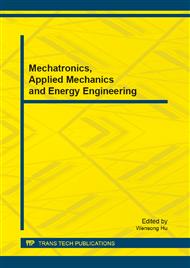[1]
M.J. Ablowitz and P.A. Clarkson: Soliton, Nonlinear Evolution Equations and Inverse Scattering (Cambridge University Press, New York 1991).
Google Scholar
[2]
R. Hirota: Phys. Rev. Lett. Vol. 27 (1971), p.1192.
Google Scholar
[3]
M.R. Miurs: Bäcklund Transformation (Springer, Berlin 1978).
Google Scholar
[4]
J. Weiss, M. Tabor and G. Carnevale: J. Math. Phys. Vol. 24 (1983), p.522.
Google Scholar
[5]
W. Malfliet: Am. J. Phys. Vol. 60 (1992), p.650.
Google Scholar
[6]
C. Yan: Phys. Lett. A Vol. 224 (1996), p.77.
Google Scholar
[7]
M.L. Wang: Phys. Lett. A Vol. 213 (1996), p.279.
Google Scholar
[8]
J.H. He: Chaos Soliton. Fract. Vol. 26 (2005), p.695.
Google Scholar
[9]
J.H. He: Phys. Lett. A Vol. 335 (2005), p.182.
Google Scholar
[10]
J.H. He: Int. J. Modern Phys. B Vol. 10 (2006), p.1141.
Google Scholar
[11]
J.H. He: Non-Perturbative Methods for Strongly Nonlinear Problems, Dissertation, (de-Verlag im Internet GmbH, Berlin 2006).
Google Scholar
[12]
T.A. Abassy, M.A. El-Tawil and H.K. Saleh: Int. J. Nonlinear Sci. Numer. Simul. Vol. 5 (2004), p.327.
Google Scholar
[13]
S.K. Liu, Z.T. Fu, S.D. Liu and Q. Zhao: Phys. Lett. A Vol. 289 (2001), p.69.
Google Scholar
[14]
Y.B. Zhou, M.L. Wang and Y.M. Wang: Phys. Lett. A Vol. 308 (2003), p.31.
Google Scholar
[15]
Sirendaoreji and J. Sun: Phys. Lett. A Vol. 309 (2003), p.387.
Google Scholar
[16]
Sirendaoreji: Chaos Soliton. Fract. Vol. 19 (2004), p.147.
Google Scholar
[17]
C.P. Liu and X.P. Liu: Phys. Lett. A 348 Vol. (2006), p.222.
Google Scholar
[18]
Sirendaoreji: Phys. Lett. A Vol. 356 (2006), p.124.
Google Scholar
[19]
S. Zhang and T.C. Xia: Phys. Lett. A Vol. 363 (2007), p.356.
Google Scholar
[20]
E.J. Parkes, B.R. Duffy and P.C. Abbott: Phys. Lett. A Vol. 295 (2002), p.280.
Google Scholar
[21]
M. Boiti, J.J.P. Leon, M. Manna and F. Pempinelli: Inverse Problem Vol. 2 (1986), p.271.
Google Scholar
[22]
S.Y. Lou and X.B. Hu: J. Math. Phys. 38 Vol. (1997), p.6401.
Google Scholar
[23]
S.Y. Lou: J. Phys. A: Math. Gen. Vol. 28 (1995), p.7227.
Google Scholar
[24]
S.Y. Lou: J. Phys. A: Math. Gen. Vol. 34 (2001), p.305.
Google Scholar
[25]
W.H. Huang and Y.L. Liu: Commun. Theor. Phys. Vol. 44 (2005), p.401.
Google Scholar
[26]
J. Lin and F.M. Wu: Chaos Soliton. Fract. Vol. 19 (2004), p.189.
Google Scholar
[27]
Y.Z. Peng: Phys. Lett. A Vol. 351 (2006), p.41.
Google Scholar


